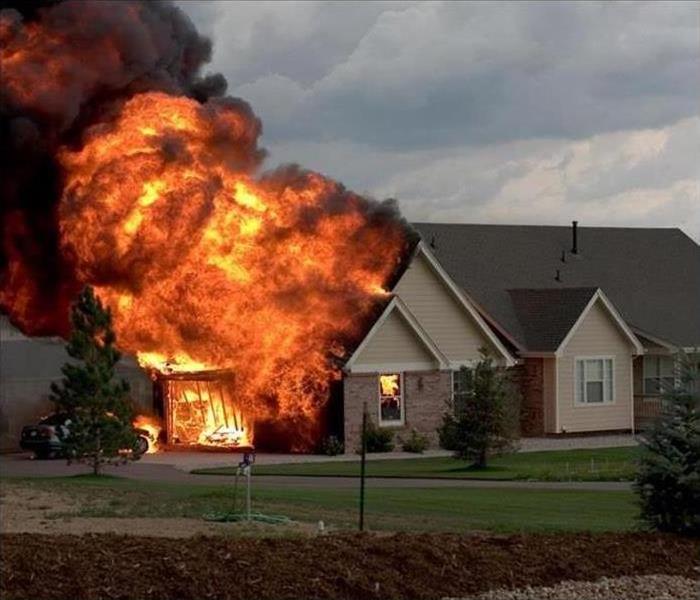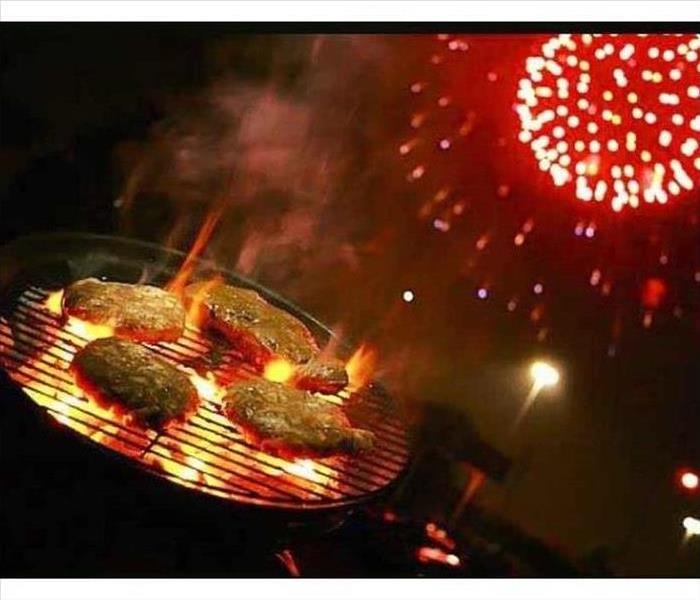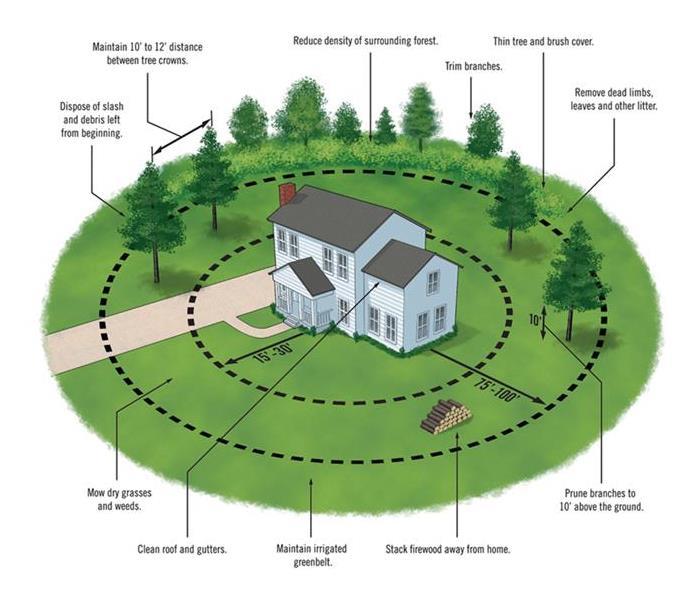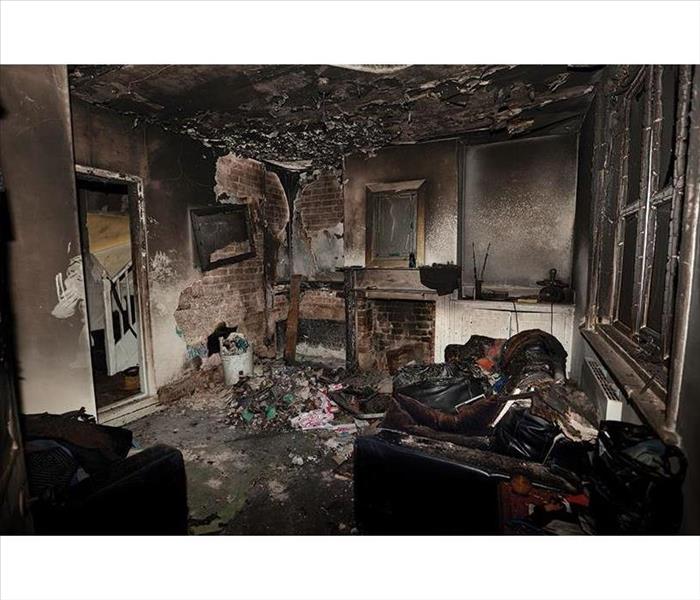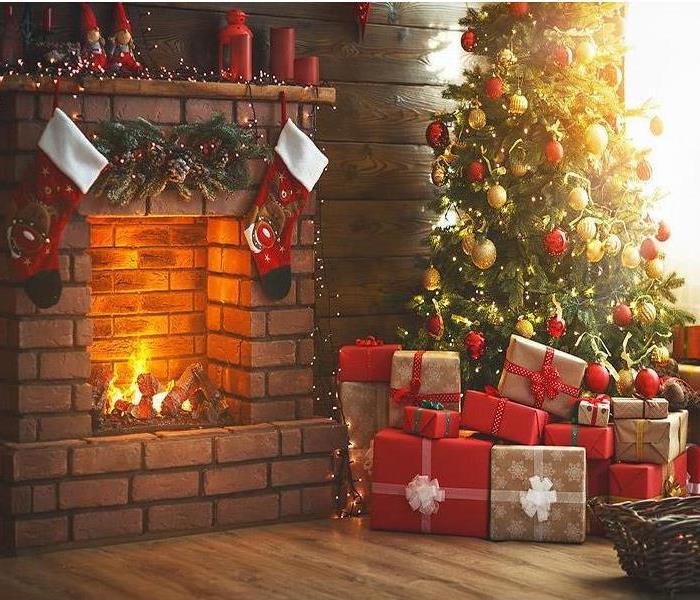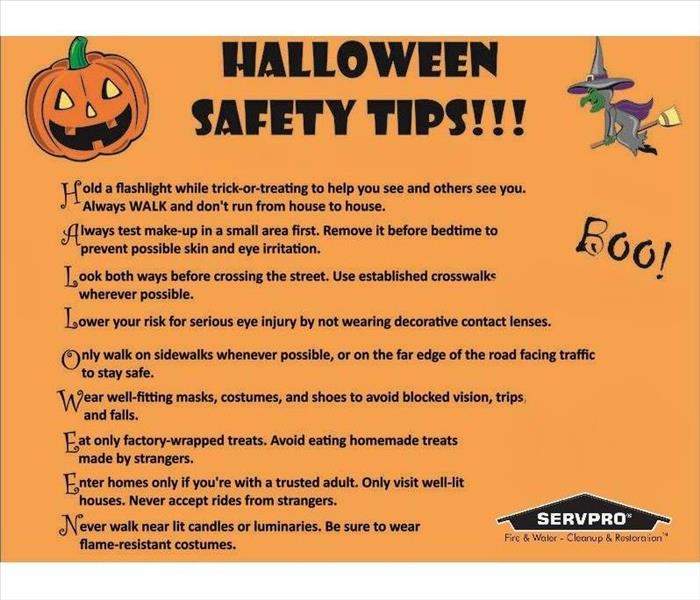Archived Fire Damage Blog Posts
Holiday Fire Tips!
2/7/2025 (Permalink)
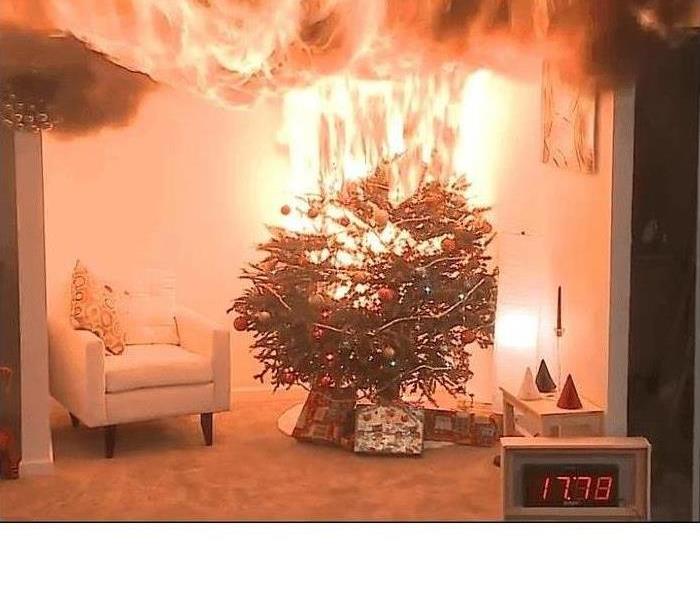 Fire beside christmas tree
Fire beside christmas tree
We all love the holidays for so many reasons, but the main one has to be the excuse in having a big ol’ tree smack-dab in the middle of your living room! With the dazzling lights and priceless family ornaments that adorn it, a Christmas tree alone has the capacity to cheer even the most stubborn of all scrooges. However, while having such a spectacular display in the comfort of your own home can be magical, it can just as well pose a great fire hazard. So, here are some tips on maintaining a fire-free environment during the holidays!
-Test and update your smoke detectors yearly.
-Inspect holiday lights (especially old ones) and throw away any with frayed or pinched wires.
-If you have a real tree, make sure to keep it watered regularly.
-Always douse any fires in your fireplace before retiring for the evening.
Prevent Home Fires
7/9/2021 (Permalink)
Fire is FAST! In less than 30 seconds a small flame can turn into a major fire. It only takes minutes for thick black smoke to fill a house or for it to be engulfed in flames.
Fire is HOT! Heat is more threatening than flames. Room temperatures in a fire can be 100 degrees at floor level and rise to 600 degrees at eye level. Inhaling this super-hot air will scorch your lungs and melt clothes to your skin.
Fire is DARK! Fire starts bright, but quickly produces black smoke and complete darkness.
Fire is DEADLY! Smoke and toxic gases kill more people than flames do. Fire produces poisonous gases that make you disoriented and drowsy. Asphyxiation is the leading cause of fire deaths, exceeding burns by a three-to-one ratio.
Home fires are preventable! The following are simple steps that each of us can take to prevent a tragedy.
Cooking
- Stay in the kitchen when you are frying, grilling, or broiling food. If you leave the kitchen for even a short period of time, turn off the stove.
- Wear short, close-fitting or tightly rolled sleeves when cooking.
- Keep children away from cooking areas by enforcing a "kid-free zone" of 3 feet around the stove.
- Position barbecue grills at least 10 feet away from siding and deck railings, and out from under eaves and overhanging branches.
Smoking
- Smoke outside and completely stub out butts in an ashtray or a can filled with sand.
- Soak cigarette butts and ashes in water before throwing them away. Never toss hot cigarette butts or ashes in the trash can.
- Never smoke in a home where oxygen is used, even if it is turned off. Oxygen can be explosive and makes fire burn hotter and faster.
- Be alert - don’t smoke in bed! If you are sleepy, have been drinking, or have taken medicine that makes you drowsy, put your cigarette out first.
Electrical and Appliance Safety
- Frayed wires can cause fires. Replace all worn, old or damaged appliance cords immediately and do not run cords under rugs or furniture.
- If an appliance has a three-prong plug, use it only in a three-slot outlet. Never force it to fit into a two-slot outlet or extension cord.
- Immediately shut off, then professionally replace, light switches that are hot to the touch and lights that flicker.
Portable Space Heaters
- Keep combustible objects at least three feet away from portable heating devices.
- Buy only heaters evaluated by a nationally recognized laboratory, such as Underwriters Laboratories (UL).
- Check to make the portable heater has a thermostat control mechanism, and will switch off automatically if the heater falls over.
- Only use crystal clear K-1 kerosene in kerosene heaters. Never overfill it. Use the heater in a well-ventilated room.
Fireplaces and Woodstoves
- Inspect and clean woodstove pipes and chimneys annually and check monthly for damage or obstructions.
- Use a fireplace screen heavy enough to stop rolling logs and big enough to cover the entire opening of the fireplace to catch flying sparks.
- Make sure the fire is completely out before leaving the house or going to bed.
Children
- Take the mystery out of fire play by teaching children that fire is a tool, not a toy.
- Store matches and lighters out of children's reach and sight, preferably in a locked cabinet.
- Never leave children unattended near operating stoves or burning candles, even for a short time.
More Prevention Tips
- Never use stove range or oven to heat your home.
- Keep combustible and flammable liquids away from heat sources.
- Portable generators should NEVER be used indoors and should only be refueled outdoors or in well ventilated areas.
For more information on fire information and prevention, please visit - https://www.ready.gov/home-fires
Fourth of July Safety Tips
7/2/2021 (Permalink)
It’s that time again for 4th of July celebrations! Whatever you have planned; whether its just fireworks, a backyard barbecue, or maybe a quick trip to the beach, SERVPRO wants to make sure you take all safety precautions this holiday!
FIREWORKS SAFETY The safest way to enjoy fireworks is to attend a public fireworks show put on by professionals, while maintaining a safe distance. While the majority of the states prohibit most fireworks- If you, or someone you know is setting fireworks off at home, follow these safety steps:
- Never give fireworks to small children, and abide by the directions on the packaging.
- Keep a supply of water close by as a preventative measure.
- Make sure the person lighting fireworks always wears eye protection.
- Never toss or point a firework in the direction of people, animals, vehicles, structures or flammable materials.
GRILLING SAFETY Every year people in this country are injured while using backyard charcoal or gas grills. Follow these safety tips to carefully grill up treats for the backyard barbecue:
- Always supervise a barbecue grill when in use.
- Never grill indoors
- Make sure everyone (including the pets) stays away from the grill.
- Keep the grill out in the open, and away from anything that could potentially catch on fire.
- Never add charcoal starter fluid when coals have already been ignited.
- Always follow the manufacturer’s instructions when using grills.
BEACH SAFETY If someone’s visit to the shore includes swimming in the ocean, they should make sure they know how to swim, and stay by a lifeguard station.Obey all instructions and orders from lifeguards. Rip currents are responsible for deaths on our nation’s beaches every year, and for most of the rescues performed by lifeguards. Any beach with breaking waves may have rip currents. Be aware of the danger of rip currents and remember the following:
- Keep alert for local weather conditions. Check to see if any warning signs or flags are posted.
- Swim sober and always swim with a buddy.
- Have young children and inexperienced swimmers wear a Coast Guard-approved life jacket.
- Keep a close eye and constant attention on children and adults while at the beach. Wave action can cause someone to lose his or her footing, even in shallow water.
- If someone is caught in a rip current, swim parallel to the shore until out of the current. Once free, they should turn and swim toward shore. If they can't swim to the shore, they should float or tread water until free of the rip current and then head toward shore.
- Stay at least 100 feet away from piers and jetties. Permanent rip currents often exist near these structures.
SUN PROTECTION Limit exposure to direct sunlight between 10 a.m. and 4 p.m., during the peak heat hours of the day. Wear a broad-spectrum sunscreen with a protection factor of at least 15, and reapply sunscreen as often as needed. Remember to drink plenty of water regularly, even if not thirsty. Minimize drinks with alcohol or caffeine in them. Protect the eyes by wearing sunglasses that will absorb 100 percent of UV sunlight. During hot weather, watch for signs of heat stroke—hot, red skin; changes in consciousness; rapid, weak pulse; rapid, shallow breathing. If it’s suspected someone is suffering from heat stroke immediately call 9-1-1 and move the person to a cooler place.
The Front Line of Wildfires
6/16/2021 (Permalink)
 In 2016, 60,932 human-caused wildfires burned nearly
4 million acres.
In 2016, 60,932 human-caused wildfires burned nearly
4 million acres.
From prevention to containment, learn about the many types of wildland firefighters protecting our nation from the ravages of unwanted wildfires.
- Wildfire Prevention Specialists/Program Managers
Implement plans with partners to promote wildfire prevention within their region, state, forest, or community.
- Wildfire Prevention & Patrol Specialists
Provide education in the classroom and community, write warnings for violations that may cause fires, perform initial attack on new fires, and investigate fires to determine their cause.
Though used less often today due to other forms of aerial detection, lookouts are stationed in towers in remote areas or during times of heavy lightning to observe, plot and report locations of fires.
Lookouts spend days, weeks or months alone in some of the wildest, most remote places in the country. Life is rustic in a fire tower, but lookouts have provided an invaluable service for 100 years.
- Fire Prevention & Education Teams
Skilled and mobile personnel who enhance local wildfire prevention activities where risk is elevated. They reduce unwanted human-caused fire ignitions through prevention assessments and education.
Study environmental conditions, fire behavior, and the effects of fire. They also provide predictive services and offer management options before, during and after wildfires and prescribed fires.
Fuels specialists and prescribed fire managers develop and implement plans for maintaining healthy ecosystems where fire plays a necessary role. Using the best available science, specialists determine treatments and timing, which can include mechanically removing vegetation or prescribed burning during different times of the year.
Prescribed fire managers, along with fuels specialists, develop plans and implement prescribed fires to maintain healthy ecosystems where fire plays a necessary role.
With years of extensive training and experience, fire managers analyze wildfires to determine a suppression strategy and assemble the firefighters and equipment needed to implement it.
These crews, of about 20 firefighters, are the foundation of wildland firefighting. They often work 12-hour shifts using hand tools to create the fireline, a perimeter cleared of flammable materials.
They also eliminate hotspots, monitor unburned areas to make sure sparks don’t jump the line, and “mop up” contained areas of the fire by making sure it is completely extinguished
These crews, which range in size from three to five firefighters, operate heavy equipment such as bulldozers and tractor plows to indirectly attack wildfires by clearing vegetation and constructing firebreaks around the perimeter of the fire.
The most experienced handcrews, hotshots meet stringent qualifications and work in some of the roughest, most remote terrains, on the most complex fires. They are highly mobile and self-sufficient.
Helitack crews are specially trained to use helicopters to fight wildfires. They sometimes even rappel from helicopters to reach fire in remote areas quickly. They are often first to reach a wildfire.
Since 1940, highly skilled and physically fit smokejumpers have parachuted to wildfires that can’t otherwise be reached. They are often supported by cargo drops of food, water and firefighting gear.
Engine crews, which range in size from three to five firefighters, work with fire engines that carry 250 to 750 gallons of water and several hundred feet of hose to directly attack wildfires.
- Incident Management Teams
Fire experts whose main responsibility is to develop and implement strategies to fight wildfires by managing the equipment, transportation and other goods and services wildland firefighters need.
Defensible Space Around Your Home
6/15/2020 (Permalink)
Did you know that the County of San Diego amended an ordinance that requires residents to keep their property free of fire hazards. Residents comply by creating a “Defensible space” around their homes. This includes (but is not limited to) mowing and properly maintaining lawn and weeds, removing ignitable trees and shrubs, stacking firewood away from the home and ensuring that the home’s address is visible to all emergency vehicles.
WHAT ELSE SHOULD I DO TO PROTECT MY PROPERTY AGAINST FIRE?
- Fluctuate the height of plants and space them out adequately. (Taller plants should be spaced wider apart than the shorter ones)
- Eliminate any tree limbs within 10 feet of your chimney.
- Work with your neighbors to clear shared areas between houses.
- Avoid planting trees under or near electrical lines.
- If you have a heavily wooded area on your property, removing dead, weak or diseased trees may improve growing conditions.
- Don’t forget to legally dispose of all your vegetation. (For inquiring about green waste recycling, you may contact your local landfill)
- Stack firewood and scrap wood piles at least 50 feet from any structure and clear away any combustible vegetation within 10 feet of the piles. (There have been instances when firefighters have ‘saved’ a home and moved on, only for wood piles to catch fire.)
- Check and clean your roofs and gutters on all structures several times annually to remove debris that can easily ignite from a spark.
Smoke Behavior
6/15/2020 (Permalink)
Fire losses can be difficult because the behavior of smoke can be unique. That is why it is important to have trained technicians at your home; and SERVPRO professionals know their smoke!
Different types of smoke
- Wet smoke – Plastic and rubbers – low heat, smoldering, pungent odor, sticky, smeary. Smoke webs are more difficult to clean.
- Dry smoke – Paper and wood – Fast burning, high temperatures, and heat rises thus making the smoke rise.
- Protein fire residue – Produced by evaporation of material rather than from a fire – Virtually invisible, discolors paints and varnishes, extreme pungent odor.
- Fuel Oil Soot – Furnace Puff Backs – While ‘puff backs’ can create havoc for you, SERVPRO can in most cases restore the contents and structure quickly.
- Other types – Tear gas, fingerprint powder and fire extinguisher residue – Special loss situations require special care. Here at SERVPRO, we are trained to handle your toughest losses.
Prepare yourself if wildfire threatens
5/14/2019 (Permalink)
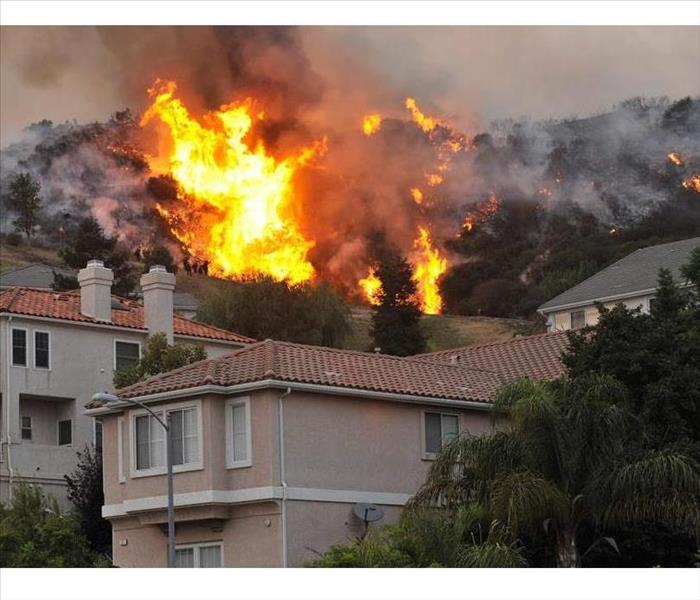 Our professionals will pretest the soot residues to determine the best method of cleaning, helping to ensure no lingering odors.
Our professionals will pretest the soot residues to determine the best method of cleaning, helping to ensure no lingering odors.
Prepare an emergency supply kit. Include items such as non-perishable food, water, battery-powered radio, extra flashlights and batteries. (you may want to prepare an extra one and leave it in your car).
Make a family emergency plan. Your family may not all be together when disaster strikes, so it is important to know how to contact one another, and what plans to execute during that trying time.
Design and landscape around your house with fire-safety in mind.
- Wear protective clothing
- Take your emergency supply kit
- Lock your home or business
- Tell someone when you left and where you are going
- Choose a route away from fire hazards
- Close windows, vents, doors, blinds, or noncombustible window coverings
- Shut off all utilities; if possible
- Move flammable furniture into the center of the room.
- Turn off propane tanks
- Wet or remove shrubs within 15 feet or the home or business.
Fire and Smoke Damage
5/6/2019 (Permalink)
Here are some emergency tips to assist you in taking the proper action until your SERVPRO Professionals arrive.
DO:
- Limit movement throughout the residence. This can help prevent soot particles from being embedded into upholstery and/or carpet.
- Keep hands clean. Having soot on your hands can help soil additional upholstery, walls, etc.
- Place dry, colorfast towels or old linen, on rugs, upholstery, and carpet traffic areas.
- Wipe soot from chrome on kitchen and bathroom faucets, trim and appliances.
- Change HVAC filter. (Leave system alone until a trained professional can check the system)
- Clean both sides of leaves from house plants.
DON’T:
- Attempt to wash any walls or painted surfaces before contacting a SERVPRO Franchise professional.
- Attempt to shampoo carpet or upholstered furniture.
- Attempt to clean any electrical appliances (TVs, Radios) that may have been close to fire, hear or water.
- Consume any food or beverages that may have been close to fire, heat, or water.
- Send garments to the dry cleaner. Improper cleaning may set in smoke odor.
Christmas tree Fire Safety
12/20/2018 (Permalink)
Did you know that annually, Christmas trees alone result in 13 million dollars in property damage? Though Christmas tree fires are not common, 1 in every 32 reported Christmas tree home fire results in death, compared to an average of 1 death per 143 reported home fires. According to the National Fire Protection Association, the top three days for home candle fires are Christmas Eve, Christmas, and New Year’s Day. Here are some steps you can follow to avoid being another statistic in the National Fire Protection Association report during this holiday season.
- Choose a tree with fresh needles that do not fall off when they are touched.
- Before placing the tree, make sure you have cut at least 2” from the base of the trunk.
- Make sure to place the tree at least three feet away from any heat source. Including, but not limited to fireplaces, candles, heaters, lights, etc.
- Make sure the tree is not blocking an exit.
- When choosing lights, make sure they are not for outdoor use only.
- Replace any string of lights with broken cords or loose bulb connections.
- Never use lit candles to decorate the tree.
- Always make sure any Christmas tree lights are off before leaving the home or going to bed.
For more information and statistics on Holiday fires, visit www.usfa.fema.gov or www.nfpa.org
Halloween Safety Tips
10/25/2018 (Permalink)
Did you know that each year from 2014 to 2016, an estimated 10,100 fires were reported to the Fire Departments in the US, over a 3-day period around Halloween? It caused an estimated 30 deaths, 125 injuries, and $102 million in Property losses.
Halloween fires take place most commonly in the late afternoon or early evening; around 6 – 7 pm. The early morning hours around 4 – 7 am is the time at which the least fires occur. Of these fires, about half were caused due to cooking, 11% was because of heating, and the remaining fires were cause by reasons such as careless actions, or electrical malfunctions, etc. For more information on Halloween Fires, and safety tips, please visit https://www.usfa.fema.gov/data/statistics/snapshot_halloween.html
Client Testimonial
4/11/2018 (Permalink)

Recently, we awoke to our fire and smoke alarms blaring at 1:20 AM to face the unthinkable - our girl's bedroom was on fire! Fortunately, the girls were fine and the fire extinguished before the Fire Department responded and thank goodness, our family escaped injury. Since we able to extinguish the fire, we thought cleaning up would be simple. Well, cleaning up after a fire is not as easy as it seems.
After a few hours of fruitless labor, we thought it a better idea to call in help. Our insurance company provided us with the names of three companies and we called the first name on the list, SERVPRO. Despite it being a Sunday morning, Ralph, the SERVPRO representative, promptly visited our house. He quickly showed us the folly of our attempt to clean up. The walls, clothing, furniture, carpets, and floors were covered in soot. In an instant, we realized that the soot from the toxic smoke was not only difficult to clean up, but a health hazard. Ralph spent extra time with us, calming and reassuring my family that things would get back to normal. We realized then that Ralph really cares about his work and the people he encounters!
The next morning, his SERVPRO crew arrived and immediately began the tedious, though important work of cleanup. From wiping down individual books to cleaning everything from floor to ceiling-including the air conditioning ducts, Ralph organized it all in a professionally and efficiently. Ralph and SERVPRO organized, with our approval, service calls to a dry cleaner and scheduled a time for our clothing, bedding, and pillows affected by the fire. Carpet and furniture cleaning were also organized and promptly completed. What helped our family to feel most comfortable was that Ralph's crew was more like an extended family. To a person, they were courteous very professional, reliable and most importantly, trustworthy. We are thankful no one injured in the fire and blessed to have people like Ralph, his crew and SERVPRO to help us recover. Our experience with SERVPRO was flawless and I would recommend them to anyone who may need the services of a great company with such wonderful employees!




 24/7 Emergency Service
24/7 Emergency Service

